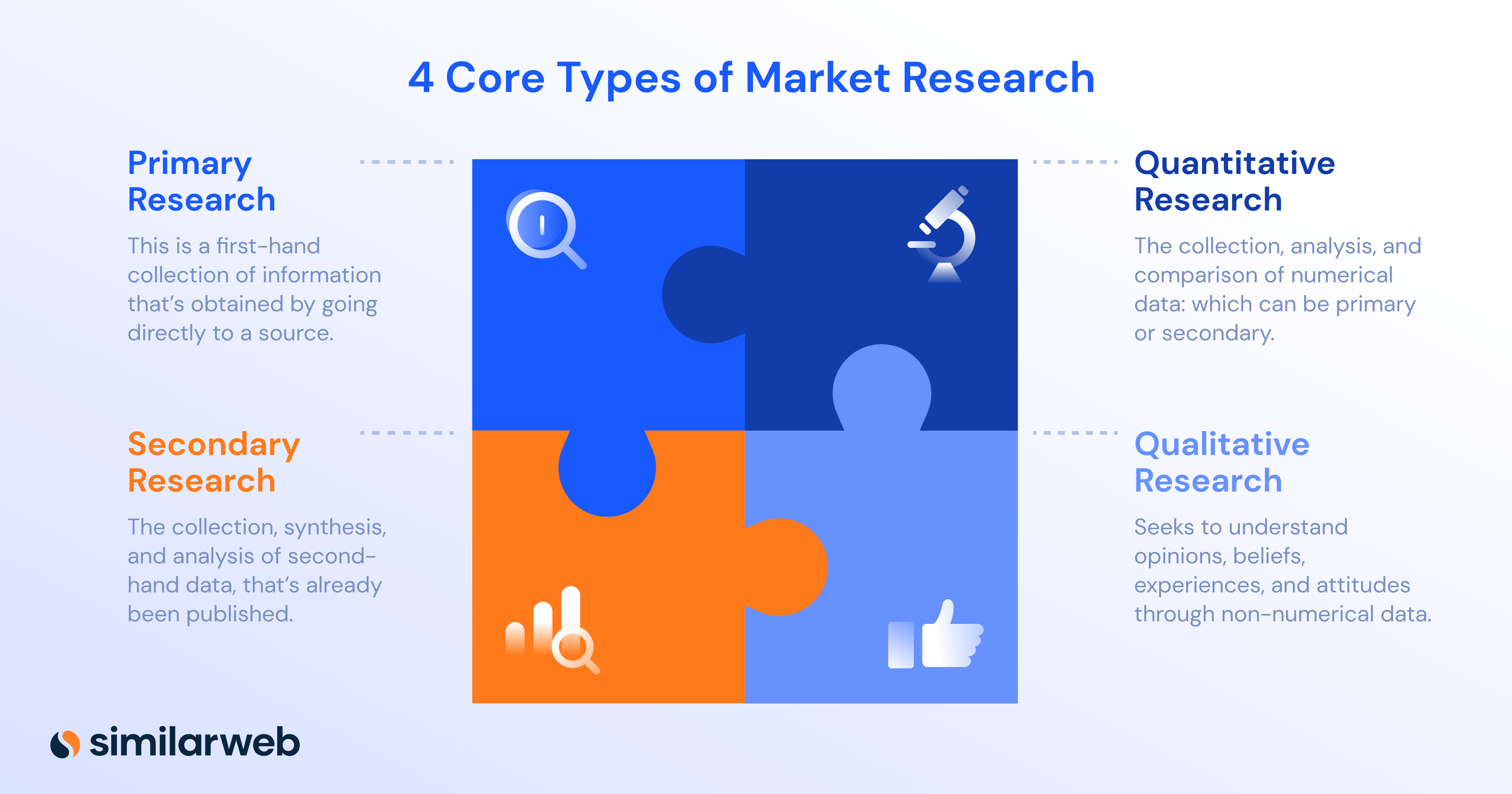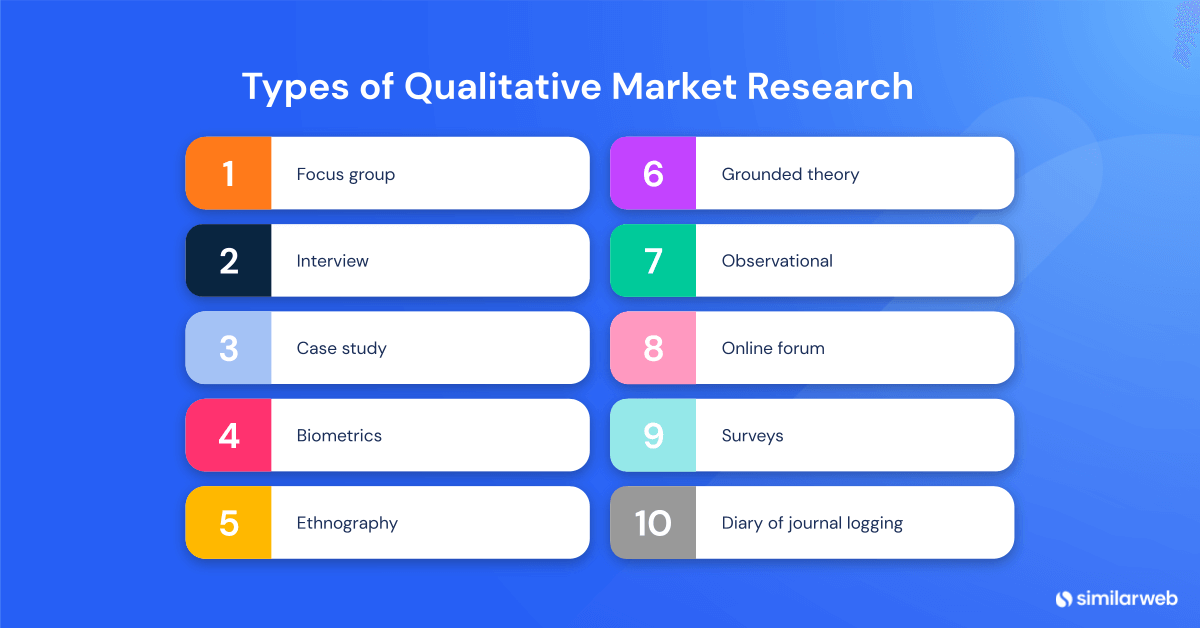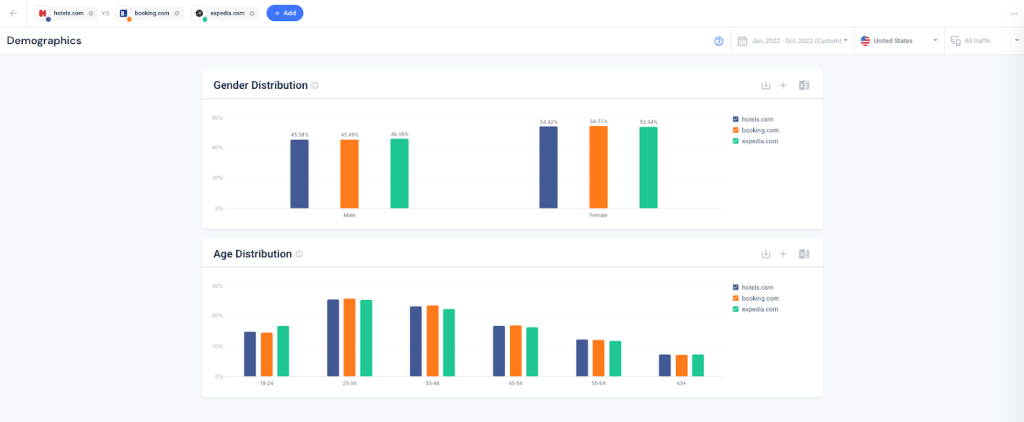Market Research: What It Is, Why It Matters, and How To Get It Right

What is market research?
What is market research used for? How important is it? And, how do you choose the right type of research for your business?
Sit back, take five, and I’ll explain the different types of research, what tools are best for the job, and how you can leverage them to grow your business and master your market.
Market research definition:
Market research means to systematically collect and analyze data about a target market or defined segment. It’s a multivariate process that uncovers key facts and insights to inform decisions.
Whether you’re launching a new product, looking for ways to expand a business, or seeking out efficiencies in an existing company, market research is a highly effective way to flesh-out ideas, innovate, and grow.
Advantages of market research
Market research helps you identify your greatest strengths, threats, and opportunities. It can help you find your way when markets become tough to predict and find efficient ways to grow your business.
- Reduce costs
- Saves time
- Define detailed customer personas
- Make data-driven decisions
- Find new opportunities for growth
- Unpack competitor’s successes
- Develop an informed content marketing strategy
- Identify trends
- Inform market analysis
- Discover the best marketing channels to use
- Find the best ways to communicate with customers
- Benchmark performance against rivals
Online market research can help the whole business at any stage of its life. When practiced consistently and systematically, you can realize its many benefits.
Why is market research important?
Market research helps you identify your greatest threats. And it also gives you a clear picture of opportunities you can capitalize on for greater returns on your business investments, or ROI.
Understanding your specific market on different levels and from different perspectives helps you reach well-informed, data-informed decisions. The process can involve multiple phases. But, if you follow a systematic approach using a market research template, your efforts will pay off.
For more, check out our blog: Importance of Market Research: 9 Reasons Why It’s Crucial for Your Business
To skip ahead and start right now, download our free pack of market research templates.
Different types of market research
Market research is a questions and answers game. Once you’ve asked the important questions, you’ll need to choose the right type of research to get your answers. There are four core types of research, each of which can be applied to help you solve a problem or gather insights to inform key decisions.
Primary market research
Primary market research is the first-hand collection of data. It’s data that’s not available to others, and can be obtained in a number of ways. Here are the most common.
- Web Metrics
Use analytics software that provides traffic and engagement metrics to understand how audiences behave.
- Observation
To observe how users behave and navigate your site, you can install software that records visits and creates heatmaps. Such tools are useful for qualitative research regarding your UX/UI and at the same time, quantify the findings.
- Customer surveys
Survey questionnaires and polls can be distributed to any number of customers through email, SMS, your site, or social media. They let you collect both qualitative and quantitative data from respondents using open-ended questions.
- Focus groups
You select a small number of people for a group discussion. A moderator leads the session with questions and records the conclusions. This is also a form of qualitative research, and you would use it to get in-depth information.
- Face-to-face interviews
Another qualitative assessment method is one-on-one interviews. Consumers representative of your target audience or a segment of it are selected to answer questions about a specific research topic.
- Phone calls
To involve a larger number of people and get more answers, you can conduct surveys over the phone. These interviews would be less specific and include fewer questions.
Helpful: A complete guide to doing primary market research
Secondary market research
Secondary research is second-hand data that has already been produced. It’s available to all who wish to consume it. Using this type of data is preferred by those who wish to keep costs low, as it can be quicker and freely available.
- Government reports and census data
Annual, quarterly, and other periodic industry reports are a rich data source to tap into. Government organizations publish statistics in areas of trade, ecommerce, and finance.
- Academic papers and educational resources
University research is a source of high-quality information. This is useful for in-depth background information on a broad scale.
- Online articles and case studies, public and commercial sources
Industry-specific publications can be a valuable source of information for market segmentation, providing you with data and insights on market trends or a specific market segment or niche.
Further reading: A complete guide to doing desk research
Qualitative market research
Qualitative market research is one of the best ways to understand how people think or feel about a brand, product, or service. It takes more time to plan and analyze the results than other market research types. However, with tools like market research surveys, there are quick and effective ways to do it.
As some of the methods are outlined in the primary and secondary research sections, I’ve included a short list of qualitative research methods below.
- Focus groups
- Case study or whitepaper
- Online forums
- Surveys
- Biometrics
- Ethnography
- Online forums
Helpful: Read the complete guide to qualitative research and 83 qualitative research questions & examples
Quantitative market research
Quantitative market research is all about numbers. It collects numerical data to help answer specific research questions. The information collected can be easily quantified and analyzed to establish trends, insights, and patterns.
With this type of research, you’ve got three core data collection methods. However, you’ve also got to consider the design of the research, which can impact which method is used.
- Interviews
- Surveys
- Polls
What is market research used for?
The applications for market research are virtually limitless. Market research can help you unravel the most complex of business challenges to reach data-driven decisions, and when used consistently, it can help you navigate turbulent times, fuel growth, and support your success. Here are just a few examples of what market research is used for, with a few real-world examples thrown in for good measure.
1. Company research
Market research allows you to shine a spotlight on any business and unpack its wins and losses for your own gain. Let’s say you are doing market research for a business plan; you’ll likely want to evaluate the successes of others in your industry. Doing systematic company research is a proven way to inform a SWOT analysis.
Doing industry analysis can show you who your industry leaders are, along with any emerging players showing exponential growth.
Let’s say I want to find out which companies to research, I would use Similarweb Digital Research Intelligence to analyze an industry. Here, I can see who my top companies to watch are instantly. It also shows me other companies showing rapid growth in my market.
Read More: How to Research a Company: The Ultimate Guide
2. Competitive benchmarking
Most of your relevant data will come from your competition. If you plan to offer something that’s new for you but already exists in the market, learn from other’s mistakes and successes. If your goal is to evaluate and optimize, collect competitors’ data, and compare it to yours. See what works for them, find their weak spots, and improve on them.
What market research gives you here, is the ability to systematically compare each of your rivals. And, it’s not as complex as it sounds either. Simply choose a type of competitive analysis frameworks to use, complete the template for each; then compare the results to uncover relevant insights.
Read More: The Why and How of Competitive Benchmarking
3. Trendspotting
Another objective for market researchers is to forecast upcoming trends. Data collection over time helps you understand the dynamics of the market. Some markets have strong seasonal fluctuations. Increased shopping during December is an obvious example, but often these shifts are not always evident unless you measure and analyze them specifically.
With the data from your historical market research, you can evaluate their impact and the likelihood you will keep seeing these trends. Based on that, you can make predictions about future developments.
4. Audience analysis
Who will find your product most useful and why?
Examining the size of your audience and the existing demand for your product or services is crucial. Understanding your target audience allows you to build your product offering and marketing strategy more efficiently. You also want to learn first-hand where people buy this type of product and how much they are willing to spend so that you can estimate your reachable market share.
Here’s a quick example of how we use Similarweb to do effective audience analysis. You can unpack key audience demographics for any site you choose. And get up-to-date stats about gender, age, location, interests, browsing habits, and more.
5. Market segmentation
There are lots of ways to segment a market. Doing this well can deliver higher conversions, reduce costs, redefine marketing strategies, and help you connect with customers on a more personal level. Market research can help you do most types of market segmentation, the most widely adopted of all is demographic segmentation. Here, you look for shared but specific characteristics of a target audience.
Using Similarweb, I can view audience demographics for a website, and compare it side-by-side with rival sites. In this example, I am looking at hotel booking sites to try and spot any difference between the respective audiences of each.
Helpful: Read our complete guide to market segmentation
6. Marketing strategy
Market research can also help you reach the right decision regarding where to advertise or market your business. After analyzing the data, you’ll know which marketing channels are most effective with your target audience. You can also use research to look at the specific keywords and ad creatives that are generating the best responses and ROI.
Similarweb Digital Research Intelligence makes this type of research effortless. Within the marketing channels tab, you can analyze an entire industry or hone in on a specific site of interest. View the various channels across social media, email, direct, organic search, paid search, and display ads to see which channels convert and where the highest channel traffic comes from.
7. Customer experience
Market research is your best way to get information that isn’t naturally visible but that may significantly affect your business. Just think, the fact that your users don’t complain doesn’t necessarily mean they are all delighted with what you offer.
While some customers tend to keep their criticism to themselves, others will be vocal and leave reviews online. Market research is a powerful tool to help inform improvements to services and products alike. Asking for feedback, listening to it, and looking at the feedback left for rivals in your market can uncover telling insights that can shape service offerings, marketing campaigns, and new feature development.
To see what people use market research for and view real-world instances of research in action, head over to our market research examples page.
Tools for market research
When we look at what market research is, the answer is always rooted in data. Over 100 years ago, vehicle manufacturers undertook extensive research to help them develop different models to suit various segments of society. Fast-forward 100 years, and we find similar applications still exist. However, what’s changed are the tools being used and, more importantly, the accessibility of those tools to a far broader audience.
There are more market intelligence tools in existence today than ever before. Here’s a quick summary of a few you can use to collect information for your market research.
- Google Trends
Google Trends is a valuable resource for quantitative research data about market tendencies and user behavior.
- Similarweb Research Intelligence
Get the freshest digital intelligence from a platform that shows the insights that count. With the ability to analyze an entire market in an instant and unpick competitors’ wins and losses online, you can count on it to help you perform quick and effective market research. - Hotjar
The digital tool lets you observe and record user behavior on your website. It also creates heatmaps of your pages so you can analyze how visitors navigate. - SurveyMonkey
Create your own online survey with this free tool. SurveyMonkey provides templates for questionnaires and lets you distribute them through your various channels, then collect and interpret results. - YouGov
This platform offers its users daily with thousands of data points and statistics on consumer attitudes, opinions, and behavior. - Pew Research Center
This non-profit organization conducts and publishes public opinion polling, demographic research, content analysis, and other data-driven social science research. - Living Facts
The site provides current statistics about the American population, including demographics, social and health issues, opinions, and more.
Read this post to see what market research tools are hot right now.
Wrapping up: what is market research
Market research is insight. It gives you information to fuel key decisions in your business. Without it, companies must navigate their market uncertainly and make key decisions based on instinct or outdated data.
Similarweb transforms the way companies do market research. There’s no expensive outlay for prolonged research reports that take an age to produce. The data is the freshest there is; it’s credible and shows traffic trends and comparable performance like no other.
Try using it to answer your next big market research question.
FAQ
What are the benefits of market research?
Effective market research helps businesses understand and improve their position while also identifying potential threats and opportunities, while also spotting emerging trends.
What is the main purpose of market research?
The main benefit of market research is insight. It can give you access to the data you need to make decisions in your business. Before you invest money or time in any venture, use market research to inform your decision.
What’s the difference between primary and secondary market research?
Primary research is research you conduct on your own that uses numbers and metrics, and secondary research is research that was done by someone else with a qualitative focus.
Track your digital metrics and grow market share
Contact us to set up a call with a market research specialist



















